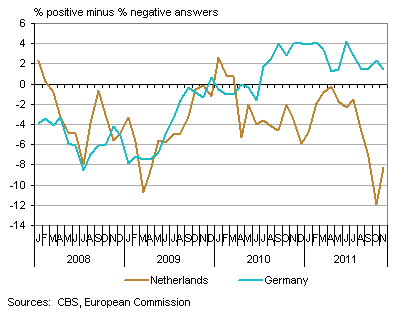Germans spending more, Dutch spending less

Dutch household consumption was 1.1 percent lower in the third quarter of 2011 than one year previously. German household consumption, on the other hand, grew by 1.2 percent. Compared to the second quarter of 2011, Dutch household consumption was also down, whereas in Germany it grew. The circumstances for household consumption are more favourable in Germany than in the Netherlands.
Consumption Radar
Statistics Netherlands has published the Consumption Radar since December 2010. This interactive diagram was developed to analyse developments in consumption by Dutch households, using indicators which reflect the labour market, consumer expectations and the development of house prices and share prices. A brief analysis makes clear that the circumstances for household consumption are more favourable in Germany than in the Netherlands. Furthermore, the rise of contractual wages was larger in Germany.
Germans much less pessimistic about labour market
In November, 71 percent of Dutch consumers expected unemployment to increase in the next twelve months, while only 5 percent anticipated a decrease. Dutch consumers have become much more pessimistic about unemployment recently.
The Germans were much less pessimistic; the number expecting unemployment to fall was nearly as high as the number anticipating an increase. The Germans have been less gloomy about unemployment than the Dutch for over one and a half year now. Incidentally, unemployment fell slightly in Germany in the third quarter, while the number of unemployed people rose considerably in the Netherlands.
Consumers’ expectations on unemployment

German manufacturers were also less pessimistic about the labour market than their Dutch counterparts. In November, manufacturers expecting the number of employees to increase in the next three months outnumbered those anticipating a decrease. In the Netherlands, manufacturers anticipated that their workforce would be reduced.
Expected workforce in the manufacturing industry

Dutch consumers gloomy about own financial future
Dutch consumers were much more pessimistic about their own financial situation than the Germans. In the Netherlands, the number of consumers expecting their financial situation to deteriorate in the next twelve months was considerably more substantial than the number anticipating an improvement. The Germans, on the other hand, were positive about their own financial future. The Dutch have been gloomier than their eastern neighbours about their financial future for over eighteen months.
Consumers’ expectations on their own financial situation

Sharp drop in Dutch house prices
The development of house prices can also affect household consumption. Rising house prices can have an upward effect, whereas falling house prices can affect consumer spending negatively. In the Netherlands, house prices have fallen significantly in the last three years. In Germany, this was not the case. House prices probably affect household consumption in Germany to a lesser extent than in the Netherlands, because home ownership is less common in Germany.
Stock market down in both countries
The stock market can also affect household consumption, since losses on the market have a negative effect on the financial situation of households. In the third quarter of 2011, both the AEX and the DAX, important indexes in the Netherlands and Germany respectively, dropped. So, in both countries, there were losses on the stock markets.
However, because of the way the respective pension systems are set up, Dutch consumers are much more sensitive to these losses. In contrast with the German system, the Dutch pension system is based on funding. This means that the premium is invested on the stock market, and that the final benefit is paid out of the returns. The percentage of cover is determined by the yield and the interest rate. At this time, both the yields and the interest rate are low. Therefore, it is likely that premiums will have to be raised and benefits will have to be lowered.
In Germany, the pension system is to a large extent based on “Pay as you go”. Thus, premiums are not invested in Germany; benefits are paid directly out of current contributions.
Contract wages rise more substantially in Germany
Finally, household consumption is also affected by the development of wages. In the third quarter of 2011, contractual wages in the Dutch market sector (special allowances excluded) were 1.5 percent up on one year previously. The rise of contractual wages was lower than inflation.
According to Destatis, the German statistical office, contractual wages in the German market sector (with the exception of agriculture, forestry and fishery) rose by 2.4 percent compared to one year previously. In Germany, the rise of contractual wages was also smaller than inflation, but the difference was smaller than in the Netherlands.
Rise in contractual wages (excl. special allowances) and inflation (HICP)

Wouter Jonkers
More figures can be found in dossier Business cycle.